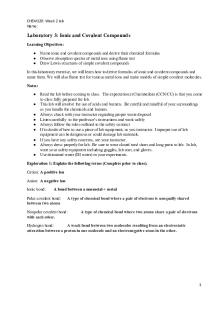Grace moody Ionic and Covalent Bonds lab report PDF

| Title | Grace moody Ionic and Covalent Bonds lab report |
|---|---|
| Author | Grace Moody |
| Course | General Chemistry Lab For Chemistry Majors |
| Institution | Oregon State University |
| Pages | 1 |
| File Size | 29.2 KB |
| File Type | |
| Total Downloads | 82 |
| Total Views | 126 |
Summary
ionic and covalent bonds lab repott...
Description
Ionic bonding is the complete transfer of valence electron between atoms. It is a type of chemical bond that generates two oppositely charged ions. In ionic bonds the metal loses electrons to become a positively charged cation whereas the nonmetal accepts those electrons to become a negatively charged ion. Ionic bonds require an electron donor, often a metal, and an electron acceptor a nonmetal. Ionic bonding is observed because metals have few electrons in their outermost orbitals. By losing those electrons, these metals can get a noble gas configuration and satisfy the octet rule. Similarly, non metals that have close to 8 electrons in their valence shells tend to readily accept electrons to achieve noble gas configuration. In ionic bonding more than 1 electron can be donated or received to satisfy the octet rule. The charges on the anion and cation correspond to the number of electrons donated or received. In ionic bonds the net charge of the compound must be zero. Covalent bonding is the sharing of electrons between atoms. This type of bonding occurs between two atoms of the same element or of elements close to each other in the periodic table. This bonding occurs primarily between nonmetals; however, it can also be observed between nonmetals and metals. If atoms have similar electronegativities covalent bonds are most likely to occur. Because both atoms have the same affinity for electrons and neither has a tendency to donate them, they share electrons in order to achieve octet configuration and become more stable. In addition, the ionization energy of the atom is too large and the electron affinity of the atom is too small for ionic bonding to occur. For example: carbon does not form ionic bonds because it has 4 valence electrons, half of an octet. To form ionic bonds, Carbon molecules must either gain or lose 4 electrons. This is highly unfavorable; therefore, carbon molecules share their 4 valence electrons through single, double, and triple bonds so that each atom can achieve noble gas configurations. Covalent bonds include interactions of the sigma and pi orbitals therefore covalent bonds lead to formation of single, double, triple, and quadruple bonds....
Similar Free PDFs

SCHU4U1 Ionic Covalent lab
- 9 Pages

Ionic and covalent bond lab
- 1 Pages

Covalent and Ionic Compounds
- 5 Pages

Ionic Bonds
- 5 Pages

LAB Covalent - Ionic (Part 1)
- 5 Pages

Ionic - lab report
- 1 Pages

Ionic and covalent bonding in Solids
- 11 Pages
Popular Institutions
- Tinajero National High School - Annex
- Politeknik Caltex Riau
- Yokohama City University
- SGT University
- University of Al-Qadisiyah
- Divine Word College of Vigan
- Techniek College Rotterdam
- Universidade de Santiago
- Universiti Teknologi MARA Cawangan Johor Kampus Pasir Gudang
- Poltekkes Kemenkes Yogyakarta
- Baguio City National High School
- Colegio san marcos
- preparatoria uno
- Centro de Bachillerato Tecnológico Industrial y de Servicios No. 107
- Dalian Maritime University
- Quang Trung Secondary School
- Colegio Tecnológico en Informática
- Corporación Regional de Educación Superior
- Grupo CEDVA
- Dar Al Uloom University
- Centro de Estudios Preuniversitarios de la Universidad Nacional de Ingeniería
- 上智大学
- Aakash International School, Nuna Majara
- San Felipe Neri Catholic School
- Kang Chiao International School - New Taipei City
- Misamis Occidental National High School
- Institución Educativa Escuela Normal Juan Ladrilleros
- Kolehiyo ng Pantukan
- Batanes State College
- Instituto Continental
- Sekolah Menengah Kejuruan Kesehatan Kaltara (Tarakan)
- Colegio de La Inmaculada Concepcion - Cebu








